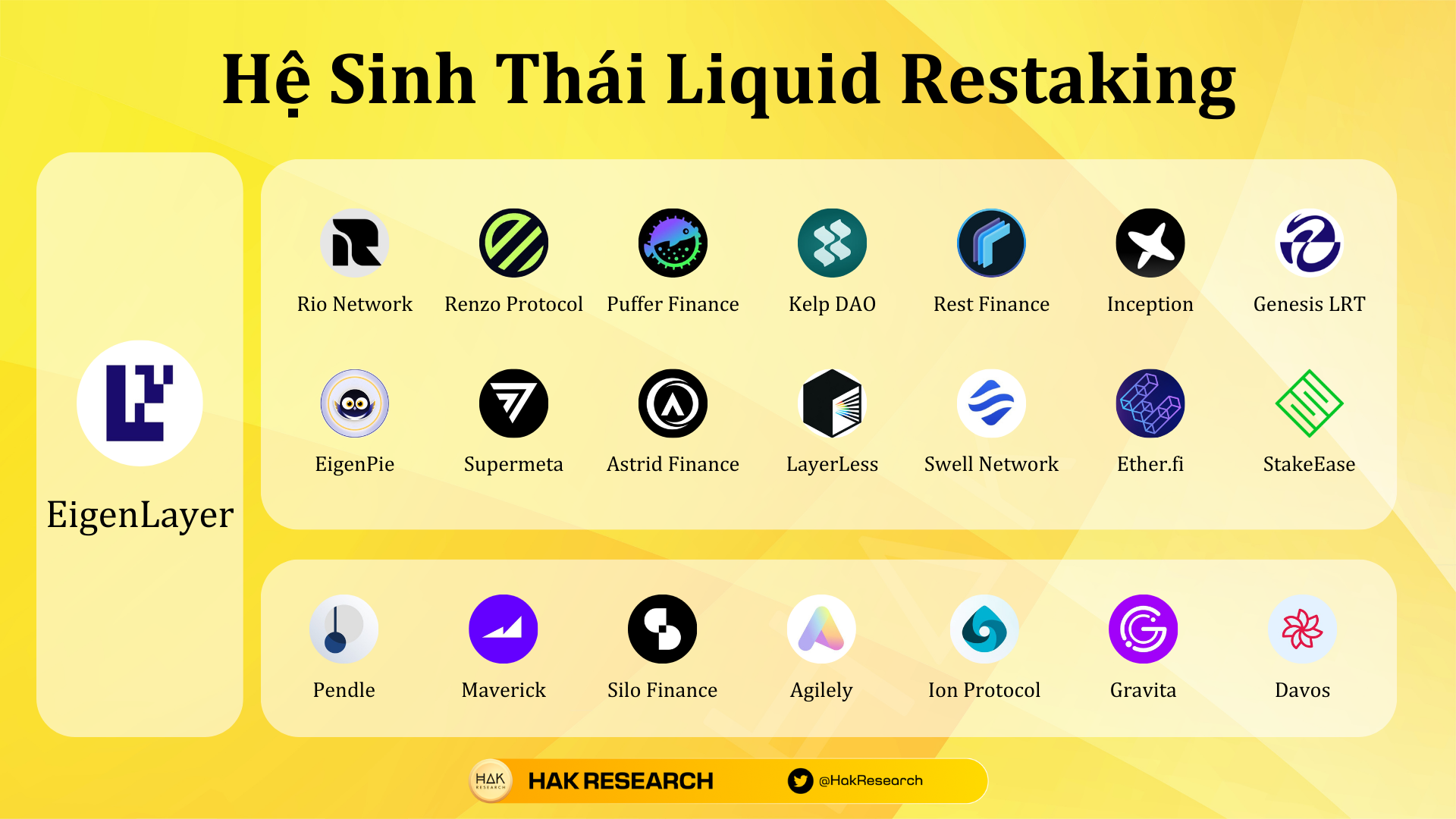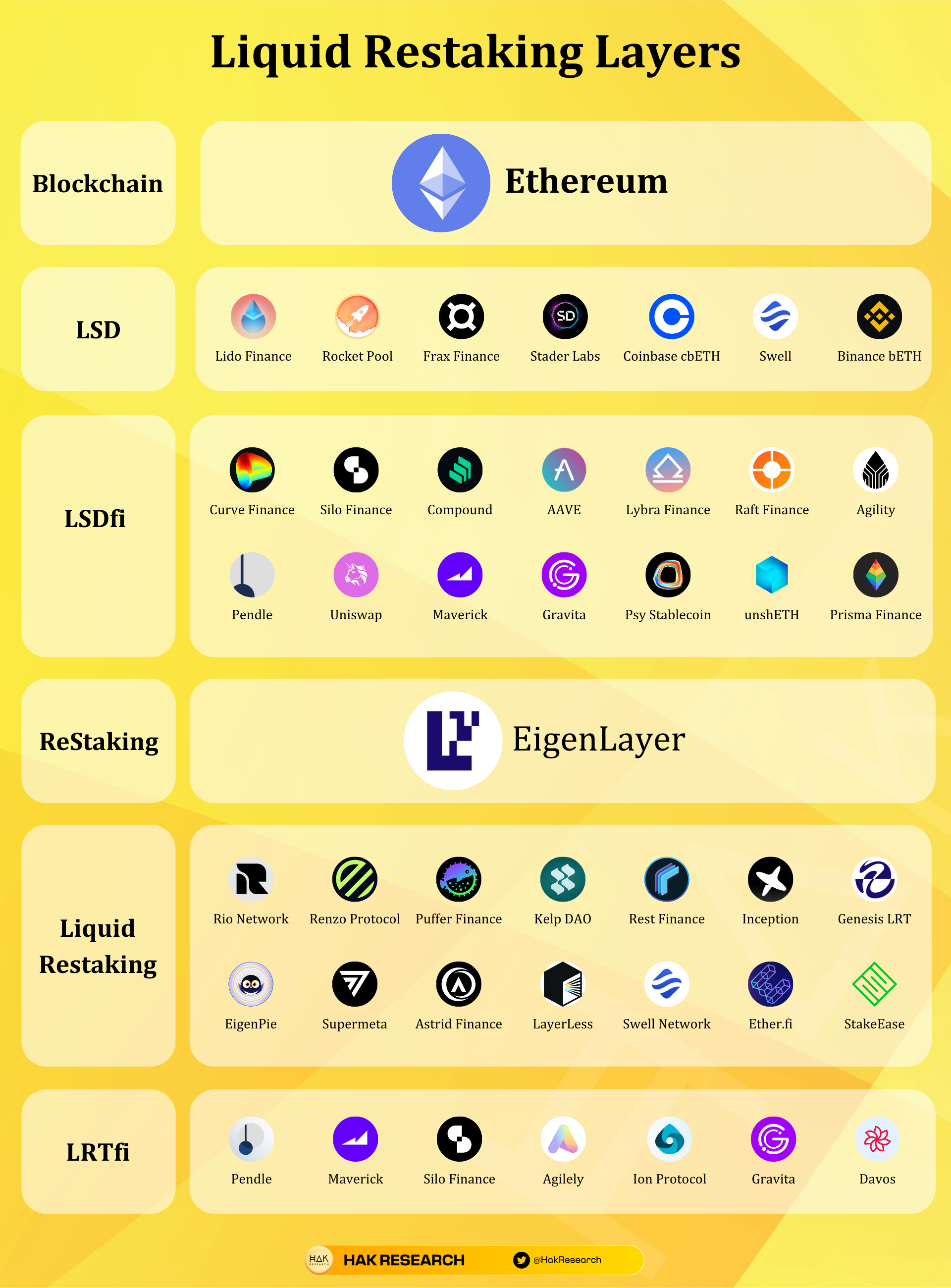What is LRTfi? LRTfi stands for Liquid Restaking Token Finance, referring to protocols built on Liquid Restaking Tokens. LRTfi is considered a strong trend following LSDfi. So what is different and outstanding about LRTfi and what are the outstanding projects in the industry? Let’s find out together in the article below.
LRTfi Overview
Background of LRTfi’s birth
If we look back at history, we can easily see that LRTfi has many similarities and origins with LSDfi. If in the context of Liquid Staking Derivatives (LSD) projects continuously being born such as Lido Finance, Rocket Pool, Frax Finance, Stader Labs,… then creating a large number of LST Tokens such as stETH, rETH , sfrxETH – frxETH, ETHx,… LSDfi are projects born with the main purpose of supporting LST Tokens.
If we look at LRTfi we can easily see it. In the context of Liquid Restaking projects continuously being born with many names such as Renzo Protocol, Rio Network, Puffer Finance, Kelp DAO, Ether.fi,… also creating a series of Liquid Restaking Tokens (LRT Tokens) such as rzETH , riETH, pufETH, rsETH, eETH,… then LRTfi will also be born projects with the main purpose of supporting LRT Tokens.
Besides, traditional DeFi projects such as AAVE, Compound, Curve Finance, Uniswap,… or LSDfi protocols such as Pendle Finance, Lybra Finance,… that support LRT Tokens are also considered projects in the LRTfi industry.
What is LRTfi?

Liquid Restaking Ecosystem
LRTfi is a combination and ecosystem of projects supporting LRT Tokens generated by Liquid Restaking or Liquid Native Restaking protocols. So LRTfi will be an ecosystem of projects including pieces such as AMM, Lending & Borrowing, Index, Yield Aggregator,…
So it can be seen that LRTfi was born to solve the problem of liquidity and use cases for LRT Tokens coming from Liquid Restaking protocols.
Potential of the LRTfi industry
Some of the growth potentials of the LRTfi industry include:
- Enhance security and reduce risk: LSDfi uses liquid assets as security to minimize the risk of loss for participating parties. This not only creates a safer investment environment but also encourages broader participation from even safety-oriented investors.
- Optimize profits: Provides the ability to optimize profits through effective management of capital and liquid assets. LRTfi makes it easier to restructure and automatically adjust portfolios, aiming to maximize profits in the DeFi environment.
- High flexibility and customization: Enables users to create complex financial products, customized to personal or business needs. This opens up opportunities for innovative and customized investment strategies, increasing accessibility and meeting diverse user requirements.
Risks in the LRTfi industry
Besides the potential, LRTfi also has some potential risks such as:
- Payment risk: While LSDfi aims to ensure liquidity, in some cases the market may face liquidity shortages, affecting users’ ability to withdraw their assets quickly and efficiency.
- Smart contract risks: DeFi protocols may experience technical problems, security vulnerabilities, or network infrastructure issues, leading to asset loss.
- Model risk: The business model and financial structure of LSDfi projects may contain inaccurate assumptions or not reflect market realities, leading to ineffective investment decisions.
TOP 5 Outstanding Projects in the LRTfi Array
Old projects promise to continue LRTfi’s boom
LRTfi will definitely become a trend in the DeFi market, whether short or long term. However, there is a high possibility that many projects in traditional DeFi or LSDfi projects may accept additional LRT Token assets to join this trend. So why are these projects participating in LRTfi? Those are transaction fees and new users.
Some of the new projects joining the LRTfi race include:
- Pendle Finance: Is a project leading the LRTfi trend with its own direction called Yield Strategy that is attracting a large number of users to participate. Pendle Finance is currently joining hands with Renzo Protocol, Kelp DAO and Ether.fi.
- Maverick Protocol: The dynamic liquidity platform also started supporting a series of PRT Tokens such as eETH, weETH, rsETH,…
- Curve Finance: The dynamic liquidity platform also started supporting a series of PRT Tokens such as eETH, weETH, rsETH,…
- Silo Finance: The Isolated Lending Pool platform also started supporting a variety of PRT Tokens such as eETH.
- Penpie: Is a project that once led the Pendle Wars race. Currently, users can provide liquidity to LRT Tokens then put LP Tokens into Penpie to earn more profits from the protocol.
- Eqilibium: Similar to Penpie, users can provide liquidity to LRT Tokens then put LP Tokens into Penpie to earn more profits from the protocol.
- VaultCraft: VaultCraft offers a range of DeFi products that help users easily implement and manage their cryptocurrency investment strategies. VaultCraft supports a wide range of assets such as Staked and Retaked Assets.
Potential projects in the LRTfi segment

In addition to well-known and experienced DeFi projects entering the LRTfi segment, a series of new projects have been launched to catch this trend including:
- Agilely: Aigilely is a lending platform built on the Aribitrum ecosystem, allowing users to use LRTs (Liquid Restaking Tokens) as collateral to borrow against the protocol’s own USDA stablecoin.
- Ion Protocol: Lending Protocol platform for many different types of collateral assets in which the protocol focuses on Staked and Retaked Assets.
- Davos Protocol: Is a CDP platform that allows users to collateralize Staked and Retaked Assets to mint the protocol’s Stablecoin DUSD. Users can use Stablecoin DUSD in DeFi to earn more profits.
Summary
LRTfi is a potential niche and has the potential to explode as strongly as LSDfi in the past. Hopefully through this article everyone can understand more about what LRTfi is?


